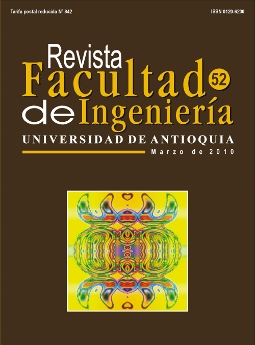Evaluation of physical properties of ethanol-water mixtures (II)
Keywords:
ethyl alcohol, ethanol, density, viscosity, conductivityAbstract
In this work, models to estimate physicals properties for ethanol-water mixtures are shown for atmospheric pressure. This is achieved through a quick and simple method with a minimum of information, starting with measurable properties. Models to estimate density, dynamic viscosity, thermal conductivity, surface tension and refractive index are based on statistic methods. Obtained values are compared with different literature sources showing, satisfactory adjustments.
Downloads
References
L. Venkatesh. “Choice of thermodynamic models for use in simulation programs”. Chemical Engineering World. Vol. 32. 1997. pp. 155-157.
Why rigorous thermodynamics?. http://www. virtualmaterials.com. Consultada el 20 de octubre de 2001.
M. A. Satyro. “Thermodynamics and the simulation engineer”. Chemical Product and Process Modeling. Vol. 3, 2008. Article 24. The Berkeley Electronic Press. Available at: http://www.bepress.com/cppm/ vol3/iss1/24.
R. H. Perry, D. W. Green. Manual del Ingeniero Químico. 6ª. ed. McGraw-Hill. México. 1999. Sección 2. pp. 112-370.
K. F. Pávlov. Problemas y ejemplos para el curso de operaciones básicas y aparatos en tecnología química. Editorial MIR, Moscú. 1981. pp. 547-560.
B. N. Stabnikov, I. M. Roiter, T. B. Prostok. Alcohol etílico. Manual. Editora Industria Alimentaria. Moscú. 1976. pp. 10-98.
J. V. Herráez, R. Belda, O. Diez. “An equation for the correlation of viscosities of binary mixtures”. Journal of Solution Chemistry. Vol. 37. 2008. pp. 233-248.
«Ethanol refractometry concentration». Mettler-Toledo International Inc. http://us.mt.com/mt/ed/appEdStyle/ Ethanol_re_e_0x000248e10002599200076b0e.jsp. Consultada el 20 de enero de 2009.
“Densities of water in SI Units», http://www. engineeringtoolbox.com/water-density-specificweight- d_595.html. Consultada el 15 de noviembre de 2008.
D. Harris. Quantitative Chemical Analysis, 4a. ed. Ed. W. H. Freeman and Company, New York. 1995. pp. 36.
Departamento Control de Laboratorios. Dirección de Producción y Entrega. Viceministerio para la Producción. Tablas para el trabajo analítico en los laboratorios de las destilerías y plantas anexas de levadura seca. MINAZ S/A. pp. 1-16.
S. Konchady. Alcohol palm book. . Praj Industries Limited. India. 2a. ed. 2004. pp. 12-45.
D. R. Lide. CRC Handbook of Chemistry and Physics. 84a. ed. online version. CRC Press. Boca Raton (Florida). 2003. pp. 2256-2257.
R. C. Reid, J. M. Prausnitz, B. E. Poling. The properties of gases and liquids. McGraw Hill Book Company. New York. 4a. ed. 1987. pp. 433-473.
R. Belda, José V. Herráez, O. Diez. “Rheological study and thermodynamic analysis of the binary system (water/ethanol): Influence of concentration”. Physics and Chemistry of Liquids. Vol. 42. 2004. pp. 467-479.
R. Jowitt, F. Escher, B. Hallström, H. F.T. Meffert, W. E. L Spiess, G. Vos. Physical properties of foods. Applied Science Publishers. London. 1983. pp. 295- 296.
T. Ackland. Ethanol-water physical properties. http:// homedistiller.org/calc.htm. Consultada el 28 de enero de 2009.
Surface tension of water in contact with air for temperatures ranging 0-1000C, http://www.engineeringtoolbox.com/water-surfacetension-d_597.html. Consultada el 25 de enero de 2009.
R. Belda, J. V. Herráez, O. Díez. “A study of the refractive index and surface tension synergy of the binary water/ethanol: influence of concentration”.Physics and Chemistry of Liquids. Vol. 43. 2005. pp. 91-101.
Alcohol and water. Some physically data: Ethanol water refractive index to air (20 0C). http://www.thewhiskystore.de/experts/alcohol.htm. Consultada el 26 de enero de 2009.
J. V. Herráez, R. Belda. “Refractive indices, densities and excess molar volumes of monoalcohols + water”. Journal of Solution Chemistry. Vol. 35. 2006. pp. 1315-1328.
Downloads
Published
How to Cite
Issue
Section
License
Copyright (c) 2018 Revista Facultad de Ingeniería

This work is licensed under a Creative Commons Attribution-NonCommercial-ShareAlike 4.0 International License.
Revista Facultad de Ingeniería, Universidad de Antioquia is licensed under the Creative Commons Attribution BY-NC-SA 4.0 license. https://creativecommons.org/licenses/by-nc-sa/4.0/deed.en
You are free to:
Share — copy and redistribute the material in any medium or format
Adapt — remix, transform, and build upon the material
Under the following terms:
Attribution — You must give appropriate credit, provide a link to the license, and indicate if changes were made. You may do so in any reasonable manner, but not in any way that suggests the licensor endorses you or your use.
NonCommercial — You may not use the material for commercial purposes.
ShareAlike — If you remix, transform, or build upon the material, you must distribute your contributions under the same license as the original.
The material published in the journal can be distributed, copied and exhibited by third parties if the respective credits are given to the journal. No commercial benefit can be obtained and derivative works must be under the same license terms as the original work.






 Twitter
Twitter